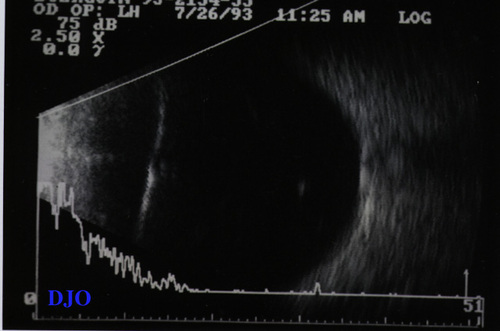|
|
 |
 |
 |
 |
|
|
General Ophthlamology Quiz 5: Ultrasound Quiz
|
Printer Friendly
|



Carmen Gonzales, MD | Massachusetts Eye and Ear Infirmary, Harvard Medical School Lois Hart, RDMS | Massachusetts Eye and Ear Infirmary, Harvard Medical School September 19, 1997
|
|
[Back to Questions] [Back to General Ophthalmology]
|

Figure 1
Figures 1-2. These are ultrasounds FROM a 56 year old man with history of congenital glaucoma OU and diabetes since 1984, who presents with a VA: OD: LP and OS: NLP. Ocular tension is 13 OU. Anterior segment shows band keratopathy OU and mature cataract OS. Ultrasound was requested to evaluate the posterior pole OD.
|

Figure 2
|
| Questions and Answers | 1. Describe the findings of the B-scan ultrasound ( Both are horizontal views).
Answer: The ultrasound shows a large globe with normal countour. There is no obvious lens or posterior capsule within the iris plane. There are low reflective vitreous echoes. The retinochoroidal layer is attached without presence of mass lesion. There is an echogenic round mobile structure within the vitreous cavity with acoustically irregular internal structure.
2. What is the most likely diagnosis and the differential diagnosis?
Answer: This is likely a cataractous lens in the vitreous of a buphthalmic eye. But this image may be mistaken for a tumor of the retinochoroid such as a choroidal melanoma and if there is history of trauma it may be mistaken for an introcular foreign body.
3. Why is important to have kinetic studies in this case?
Answer: Kinetic studies will be helpful in the differentiation between a tumor and luxated lens. An immobile mass would be more consistent with a tumor, however immobile adherent lenses can also be seen.
4. What is the axial length and is it consistent with the patient's ocular history?
Answer: The axial length is approximately 30 mm which is expected FROM the past history of congenital glaucoma and is consistent with the diagnosis of bupthalmos.
5. What other medical history may be important for this diagnosis?
Answer: A dislocated lens can be seen in a variety of conditions such as trauma, Marfan's syndrome, homocystinuria, Weill- Marchesani syndrome, syphilis, and retinitis pigmentosa so it important to obtain a thorough medical history.
| | | [Back to Questions] |
|
 |
 |
 |

|
|
 Welcome, please sign in
Welcome, please sign in  Welcome, please sign in
Welcome, please sign in